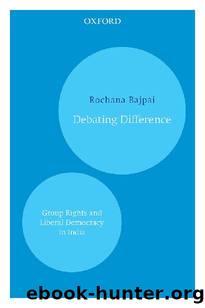Debating Difference: Group Rights and Liberal Democracy in India by Rochana Bajpai

Author:Rochana Bajpai [Bajpai, Rochana]
Language: eng
Format: epub
Publisher: OUP India
Published: 2011-03-03T00:00:00+00:00
1 Representatives from minority groups were the main, but not the sole, advocates of special rights for minorities. For instance, K.M. Munshi and Hriday Nath Kunzru spoke in favour of strong cultural rights for minorities in key debates.
2 Different combinations of these mechanisms were proposed during the Constituent Assemblyâs deliberations. For instance, proportional representation was advocated in conjunction with reserved seats, as well as an alterative to legislative quotas.
3 Separate electorates were eventually outlawed under the Indian Constitution.
4 See also Pandit G.B. Pant, CAD V: 223â4.
5 The notion that only a person belonging to the group could adequately represent it was often incomprehensible from a nationalist standpoint. Ananthasayanam Ayyangar queried: ââ¦Mr Pocker says âI want a good, honest representativeâ. What is the definition of goodness? Goodness does not come by being a Muslim or a Hinduâ¦â (CAD V: 216).
6 Arguing that separate electorates would be âsuicidalâ for minorities, Pandit G.B. Pant held: âThe minorities if they are returned by separate electorates can never have any effective voiceâ¦will you be satisfied with the pitiable position of being no more than advocatesâif advocates alone you wish to beâwhen your advocacy will be treatedâ¦with utter disregard and unconcern, which is bound to be the case when those who are the judges are not in any way answerable to your electorate?â (CAD V: 223)
7 Several minority representatives opposed parliamentary democracy as unsuitable in India on account of the presence of permanent majorities and minorities. For instance, in 1947, Dr Ambedkar had argued that a British-style parliamentary executive ârests on the premise that the majority is a political majorityâ and in India âwould result in permanently vesting executive power in a communal majority.â (Shiva Rao 1967 II: 102â3).
8 Consociational institutions are not necessarily democratic and have exacerbated ethnic conflict in several contexts.
9 Dr Ambedkar among others had put forward sophisticated arguments challenging the Indian nationalist view that separate electorates were necessarily antithetical to national unity (see Shiva Rao 1967 II: 110).
10 Dr Ambedkarâs opposition to proportional representation may have stemmed from the fact that PR did not offer minorities âa definite quotaâ of representation (Sridharan 2002: 359).
11 Supporters of a strong central government in the Constituent Assembly were ideologically diverse and included secular modernists such as Nehru and Ambedkar, as well as Hindu nationalists (see Singh 2006: 912â13).
12 See also Vallabhbhai Patelâs speech in the House, introducing the first minority report, CAD V: 199â200.
13 For instance, Vallabhbhai Patel stated: ââ¦the Scheduled Caste has to be effaced altogether from our society, and if it is to be effaced, those who have ceased to be untouchables and sit amongst us must forget that they are untouchablesâ¦We are now to begin again. So let us forget these sections and cross-sections and let us stand as one, and togetherâ (CAD V: 272).
14 Opposing Jaipal Singhâs proposals for greater autonomy for tribal areas, K.M. Munshi said that the aim of the Drafting Committeeâs proposals was that isolated tribes âshould be absorbed in the national life of the countryâ. But he
Download
This site does not store any files on its server. We only index and link to content provided by other sites. Please contact the content providers to delete copyright contents if any and email us, we'll remove relevant links or contents immediately.
| Elections & Political Process | Ideologies & Doctrines |
| International & World Politics | Political Science |
| Public Affairs & Policy | Specific Topics |
| United States |
The Secret History by Donna Tartt(16675)
The Social Justice Warrior Handbook by Lisa De Pasquale(11495)
Thirteen Reasons Why by Jay Asher(7808)
This Is How You Lose Her by Junot Diaz(5802)
Weapons of Math Destruction by Cathy O'Neil(5055)
Zero to One by Peter Thiel(4840)
The Myth of the Strong Leader by Archie Brown(4796)
Promise Me, Dad by Joe Biden(4460)
Beartown by Fredrik Backman(4442)
How Democracies Die by Steven Levitsky & Daniel Ziblatt(4427)
Stone's Rules by Roger Stone(4426)
The Fire Next Time by James Baldwin(4354)
100 Deadly Skills by Clint Emerson(4091)
A Higher Loyalty: Truth, Lies, and Leadership by James Comey(4044)
Rise and Kill First by Ronen Bergman(4026)
The David Icke Guide to the Global Conspiracy (and how to end it) by David Icke(3899)
The Farm by Tom Rob Smith(3883)
Secrecy World by Jake Bernstein(3793)
The Doomsday Machine by Daniel Ellsberg(3742)
